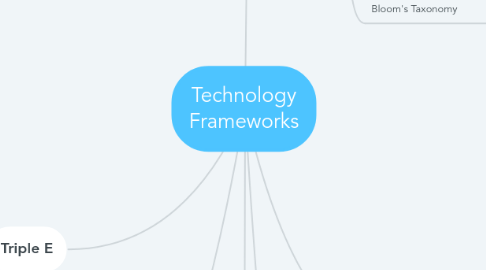Technology Frameworks
by Addy LaFond

1. Triple E
1.1. -The Triple E is a practical framework that measures the degree to which the technology in a lesson is helping students meet the learning goals.
1.2. -Created to address the desire for K-12 educators to bridge research on education technologies and teaching practice in the classroom.
1.3. -Engagement in learning goals, Enhancement of learning goals, and Extension of learning goals. While these terms are often used interchangeably, they are distinct and different.
1.4. -The Triple E Framework is meant to be used as a coaching tool to support teachers in their instructional choices around and with technology tools.
1.5. -The Triple E is that practical tool that brings together instructional strategies, learning goals and purposeful tool selection.
1.6. -As the U.S. has become focused on standardizing learning and outcomes, making sure that students are using their time to meet learning goals is even more vital when integrating technology. This is where the Triple E Framework can help to extend the current models.
2. PICRAT
2.1. -Gives us evaluation for both what the teacher and student are doing with and using the technology for. It clarifies a little more from previous models what good practice looks like and how it involves student use.
3. Similarities:
3.1. -Each model helps educators evaluate the effectiveness and appropriateness of the use of technology
3.2. -Can be effective in unique/diverse classrooms with unique/diverse students
3.3. -Gives ideas of new tools and their uses/application within the classroom
3.4. -Can help educators plan and execute the best technology integration
3.5. -None are linear models where one thing needs to be done before the others
4. SAMR
4.1. Substitution (Enhancement):
4.2. Technology acts as a direct substitute, with no functional change.
4.3. Augmentation (Enhancement):
4.4. Technology acts as a direct substitute, with functional improvement.
4.5. Modification (Transformation):
4.6. Technology allows for significant task redesign.
4.7. Redefinition (Transformation):
4.8. Technology allows for the creation of new tasks, previously inconceivable.
4.9. -Viewed as more of a spectrum rather than a ladder
4.10. -"On one end technology is used as a one-to-one replacement for traditional tools, and on the other end technology enables experiences that were previously impossible without it."-Schoology.com
4.11. -Often used in tandem with Bloom's Taxonomy
5. TPACK
5.1. Content Knowledge:
5.2. What are you teaching and what is your own knowledge on the subject?
5.3. Pedagogical Knowledge:
5.4. How do your students learn best and what instructional strategies do you need to meet their needs and the requirements of the lesson plan?
5.5. Technological Knowledge
5.6. What digital tools are available to you, which do you know well enough to use, and which would be most appropriate for the lesson at hand?
5.7. -All three come together to represent a full understanding of how to teach with technology.
5.8. Technological Pedagogical Knowledge (TPK)- Understanding how to use your digital tools as a vehicle to the learning outcomes and experiences you want.
5.9. Technological Content Knowledge (TCK)- Knowing how the digital tools available to you can enhance or transform the content, how it’s delivered to students, and how your students can interact with it.
5.10. Pedagogical Content Knowledge (PCK)- Understanding the best practices for teaching specific content to your specific students.
6. Differences:
6.1. -The TPACK model focuses on the knowledge required to meaningfully integrate technology while the SAMR model focuses more on what meaningful technology integration looks like in the classroom.
6.2. -SAMR has different options that are each effective in different circumstances, while TPACK overlap and work best when all used together along with Triple E.
6.3. -TPACK is based around the prior knowledge of the teacher and their understanding of the subject material, while SAMR is geared toward the students and expanding their knowledge on the content being taught in different ways.


